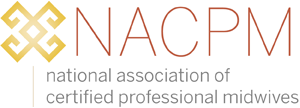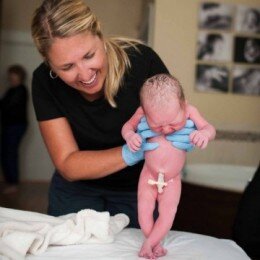“Organizations have a calling to contribute something energetically, valuably to the world, and an evolutionary energy to move toward that calling.” *
The NACPM Board of Directors is taking an extraordinary new direction this year by electing Tanya Khemet and Audrey Levine as Co-Presidents. This decision builds on two important commitments. The first is our commitment to social justice and birth, which includes learning about and addressing racism in maternity care and midwifery. Choosing a cross-racial partnership for our Co-Presidents gives us an opportunity to deepen our practice of challenging racism within our leadership team and bring what we’re learning to our membership and the maternity care system more generally.
The second commitment is to strengthen our model of distributed leadership, which means that we work in self-managed teams and all are encouraged to participate in core leadership decisions. Over the last 4 years, we have learned to operate more effectively, using a team-based/work-focused approach, thanks to the skillful and dedicated leadership of our immediate past President, Ellie Daniels, and the invaluable support of Cari Caldwell and Shirley McAlpine, our brilliant and inspiring co-facilitators from Birthwise Consulting.
We have made use of the best available web-based project management and collaboration tools, and have become a more “leader-full” organization, committed to creating a culture that fully engages the skills, talents, energy, and expertise of our staff, board, volunteers, and other stakeholders. We have also challenged ourselves to become a “learning organization,” a community committed to growing together toward a shared vision and purpose. Through this commitment to interconnected thinking and organized and shared learning, we have experienced more openness, enhanced communication, and greater productivity. In essence, we have learned that “none of us is as smart as all of us.”
This lesson was brought home powerfully during the 2012 CPM Symposium where we posed the question, “What most requires our shared attention?” and we heard from the midwives of color in attendance that we must address the systemic racism in our culture that shows up in the tragic disparities in birth outcomes and is also present in our midwifery profession. The Symposium created a space for courageous conversations about how midwifery in the U.S. must shift in order to ensure that all families have access to this kind of comprehensive and compassionate care. And it generated energy and a commitment to confront racism within the midwifery profession so that we can work together as allies and effect change.
Since the CPM Symposium, NACPM has taken the following steps in the pursuit of health equity:
We drafted a statement of Strategic Intention
NACPM Board members and staff completed an 11-week course: Critical Conversations on Power and Privilege
We created two appointed positions on our leadership team for people of color
We are continuing to recruit people of color to our organization, recognizing the important impact of having a more representative critical mass
We are ready to implement the Racial Equity Tool created by Wendy Gordon and introduced in her article in the November issue of the Journal of Midwifery and Women’s Health. The article highlights the foundational work that NACPM has done to become a more racially just organization. Integrating this racial equity impact tool into our work going forward will allow us to consider and attempt to mitigate the unintended consequences that our initiatives, projects, and organizational policies and practices might have on various communities of color
Additionally, we have clarified what NACPM’s role should be in promoting equity in maternity care access and improving outcomes for all childbearing families and their babies, which is:
To amplify the voices and the work of midwives of color, help bring the necessary resources to that work, and use our privilege and access to help scale the innovative models of midwifery care and community-based doula programs that have emerged in communities of color and are having such a transformative impact
To advocate for legislative change as well as changes in education that will grow a diverse, representative, and sustainable midwifery workforce to meet the maternity care needs of our increasingly diverse population—with a particular commitment to meeting the urgent needs of the most vulnerable communities
With these pieces in place, embracing a model of cross-racial shared leadership was the logical next step. We were inspired, in part, by the work of Robin DiAngelo and Darlene Flynn, who have found that “working collaboratively as a cross-racial team challenges racism by interrupting unilateral white leadership.” ** Why is this important for NACPM? Because we will not be able to deliver on our goal of becoming a more socially just organization or fulfill our strategic intention of eliminating inequity in maternity care access and outcomes unless those of us who are white learn how to partner with and take leadership from people of color. And because this is the only way that addressing systemic racism and the pernicious ways that it affects the health of communities of color will rise to the top of our agenda and become one of our most urgent priorities.
As DiAngelo and Flynn note, this interruption of typical norms for leadership is key not only for the organization being led, but also for the leaders themselves. We see this configuration as a powerful laboratory for cultivating cross-racial skills and an opportunity to practice interrupting socialized patterns of racism. We don’t anticipate that co-leadership will be easy. Authentic cross-racial leadership requires sustaining honest and courageous dialogue about how racism manifests, solving problems, coordinating efforts, acknowledging and responding to racial mistakes, and resolving conflicts. We believe these challenges will make us stronger.
And it is critical that, as a community, too, we build that muscle so that we can take in and really understand the whole picture. The current research on epigenetics and the life-course perspective make it abundantly clear that the cumulative stress of living in a racist society has profound and lasting impact on the long-term health of people of color, most notably African Americans and Native people. This is why it’s so important for those of us committed to improving the health of all childbearing families to educate ourselves about systemic racism, examine our own implicit biases, and build our “racial stamina” by staying in conversations that are often painful and difficult so that we can learn from one another and truly make amends. To quote Maya Angelou: “I did then what I knew how to do. Now that I know better, I do better.”
To those of you who are wondering what took us so long to get here, thank you for urging us forward. Your impatience has been a virtue. We will continue to listen and learn. To those of you who are just entering this conversation about racism and its impact on maternal-child health in the U.S. and want to explore what you can do to promote health equity, we invite you to participate in NACPM’s upcoming webinar series on health equity, join the AROM (Anti-Racism and Oppression in Midwifery) FaceBook group which grew out of the 2012 CPM Symposium, and check out the abundant and continually growing list of resources on the NACPM website’s social justice page. Our whole profession is on a journey. Welcome aboard.
* Reinventing Organizations: A Guide to Creating Organizations Inspired by the Next Stage of Human Consciousness, Frederic Laloux, 2014
** “Showing What We Tell,” Robin DiAngelo and Darlene Flynn, 2010






